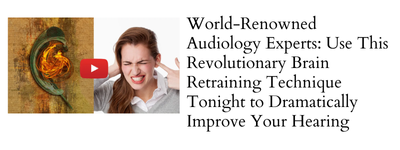Tinnitus, characterized by the perception of noise or ringing in the ears, affects millions of individuals worldwide. It’s a symptom linked to various underlying conditions such as age-related hearing loss, exposure to loud noise, or ear injuries. Specifically for those experiencing tinnitus, finding the right hearing aid can be crucial in managing day-to-day life. Although tinnitus has no cure, hearing aids have been known to provide relief to many sufferers, as they can amplify external sounds, making the internal noise less noticeable.

Selecting an effective hearing aid for tinnitus involves considering several key factors, including the type of hearing aid, the advanced features offered, and the degree of personalization it allows. Some hearing aids come with innovative technology such as noise generators or sound masking features which can help in tinnitus management. Moreover, connectivity options like Bluetooth and control features through smartphone integration can greatly enhance user experience. It’s essential for individuals to also factor in costs, potential insurance coverage, comfort, battery life, brand trustworthiness, and the availability of professional aftercare when choosing a hearing aid.
Key Takeaways
- Hearing aids can alleviate tinnitus symptoms by amplifying external sounds and reducing the perception of internal noise.
- The effectiveness of a hearing aid for tinnitus is enhanced by features like sound masking, connectivity, and user control options.
- Considering personal comfort, pricing, brand reputation, and professional services is critical in selecting a suitable hearing aid for tinnitus management.
Understanding Tinnitus and Hearing Aids
Tinnitus manifests as a persistent ringing, buzzing, or hissing in the ears, not caused by external sounds. It can result from various underlying conditions or as a symptom of hearing loss. Hearing aids are often recommended for individuals with tinnitus, especially when it coincides with hearing impairment.
The connection between hearing aids and tinnitus relief rests on two main principles:
- Amplification: Hearing aids increase the volume of external noise which can help distract the brain from the internal sound of tinnitus.
- Masking: Some hearing aids come with a ‘masking feature’ that produces white noise or other sounds to help reduce the perception of tinnitus.
Features to look for in hearing aids for tinnitus:
- Sound Generator: Many devices include integrated sound therapy options.
- Customizability: The ability to adjust settings and levels of amplification.
- Wireless Connectivity: Connectivity to smartphones or other devices may allow for more personalized sound therapy options.
- Directional Microphones: They help the wearer focus on sound from a specific direction, which can be useful in noisy environments.
When selecting a hearing aid for tinnitus management, it is crucial for individuals to consult with audiologists. They can assist in finding a device that is tailored to one’s particular hearing profile and tinnitus characteristics. Each person’s experience with tinnitus is unique, and hearing aids should be programmed to address specific frequencies and levels of hearing loss.
Types of Hearing Aids for Tinnitus
Selecting the right hearing aid for tinnitus involves understanding how different types cater to varying needs. Each design offers unique features that may alleviate the symptoms of tinnitus.
In-the-Ear (ITE)
ITE hearing aids fit within the outer ear bowl (concha) and are custom made to fit the user’s ear. They often include technology that generates white noise or other sounds to mask tinnitus symptoms, which can be particularly effective for those with a high frequency of pitch in their tinnitus.
Behind-the-Ear (BTE)
BTE models sit behind or on top of the outer ear with tubing that routes sounds down into the ear that attaches to an ear tip or earmold to secure them in the ear canal. These devices can be equipped with a tinnitus masker, and their larger size allows for bigger batteries and more powerful amplification.
Receiver-in-Canal (RIC)
RIC hearing aids are similar to BTE models but have the speaker built into an insertable ear dome or ear mold, which reduces the size and visibility of the device on the ear. They provide an open fit and can be used with sound therapy features for tinnitus relief, offering both comfort and cosmetic appeal.
Completely-in-Canal (CIC)
CIC hearing aids are custom fitted to sit completely inside the ear canal, making them nearly invisible. Their placement can help reduce the effect of wind noise and they are less likely to pick up extraneous sounds, which is beneficial for tinnitus sufferers seeking clarity of sound and discretion.
Hearing Aids Technology Features
Hearing aids for tinnitus not only amplify sound but also come with specialized features to manage tinnitus symptoms. These features aim to improve the user’s quality of life by mitigating the effects of tinnitus.
Sound Masking Capabilities
Sound masking is a critical feature where the device generates white noise or other sounds to distract the user from the ringing in their ears. Most modern hearing aids offer:
- White Noise Generation: Produces a static sound that masks the tinnitus.
- Notched Music Therapy: This reduces the volume of specific frequencies of music that match the tinnitus frequency, which can, over time, help the brain to ignore the ringing.
Frequency Shaping
Frequency shaping tailors the hearing aid’s response to match the user’s hearing loss and tinnitus profile. This includes:
- Frequency Compression: Alters higher frequencies to lower ones, which may be less affected by tinnitus.
- Frequency Adjustment: Enables the user to fine-tune the device to specific frequencies where tinnitus is more pronounced.
Amplification Adjustments
Hearing aids can adjust the level of amplification to provide relief from tinnitus while ensuring environmental sounds are heard. Features include:
- Volume Control: Allows the user to manually increase or decrease amplification.
- Automatic Gain Control: Automatically adjusts the hearing aid volume based on the sounds in the environment.
Connectivity and Control
For individuals with tinnitus, hearing aids that offer advanced connectivity and control options can greatly enhance daily usability and management of hearing health.
Wireless Connectivity
Most top-tier hearing aids for tinnitus are equipped with Bluetooth technology, allowing them to wirelessly connect with various devices. For example, the Phonak Audéo Marvel can stream audio directly from TVs, smartphones, and other Bluetooth-enabled devices. This feature not only improves the user experience but can also be used to stream tinnitus masking sounds, providing relief to the wearer.
Smartphone Integration
The ability to integrate with a smartphone through a dedicated app is a significant advantage for hearing aid users. The Starkey Livio AI offers a proprietary app that lets users adjust their hearing aid settings, monitor their tinnitus, and access a suite of health-tracking features. Such integration puts control directly in the hands of the user for a tailored hearing experience.
Remote Control Functionality
Remote control features are a cornerstone of modern hearing aid design, offering users the ability to adjust settings discretely. Many models such as the ReSound LiNX Quattro come with a compact remote control or offer the option to use their smartphone as such through an app. This capacity for fine-tuning ensures that users can effortlessly manage their hearing preferences in various environments.
Pricing and Insurance Coverage
When considering hearing aids for tinnitus, potential buyers should be aware that costs can vary widely based on features, technology, and brand. Prices typically range from $1,000 to $4,000 per device. High-end models with advanced features like Bluetooth connectivity, rechargeable batteries, and sophisticated noise-canceling functions can increase the cost.
Most insurance plans, including Medicare, do not cover hearing aids. However, some private insurance plans may offer partial coverage or discounts through partnered providers. It is recommended that individuals review their insurance plan details or consult with their insurance representative to understand the extent of their coverage.
- Medicaid: Rules can vary by state, but it may provide hearing aid coverage for qualifying individuals.
- Federal employee plans: Certain federal employee health plans may include hearing aid benefits.
- State mandates: Some states require insurance companies to provide hearing aid coverage for children, and a few extend this to adults.
| Insurance Type | Coverage for Hearing Aids |
|---|---|
| Medicare | Typically not covered |
| Medicaid | May cover with state variance |
| Private Insurance | Possible partial coverage or discounts |
| Federal Employee Plans | Possible benefits included |
| State Mandates | May cover children/adults |
Remember, those requiring hearing aids for tinnitus should explore all possible avenues for financial assistance. These may include nonprofit organizations, financing plans offered by audiologists, and manufacturer discounts. It’s essential to inquire about trial periods or return policies, as this can affect overall costs if the device is not a suitable match for the user’s needs.
Comfort and Personalization
When selecting hearing aids for tinnitus, the individual’s comfort and the ability to personalize the device are paramount. These factors can significantly impact the effectiveness of tinnitus management.
Custom Molding
Manufacturers often offer custom-molded hearing aids, which are tailored to the unique contours of the user’s ear canals. For example, Starkey and Widex use precise digital impressions to create hearing aids that fit snugly and comfortably, thereby reducing the likelihood of feedback and enhancing sound quality. This level of customization can prove critical in ensuring that users wear their devices consistently, which is essential for effective tinnitus management.
User Comfort Features
In addition to custom molding, user comfort is enhanced by features like:
- Soft Materials: Many brands, such as Phonak and ReSound, use hypoallergenic materials that minimize skin irritation.
- Venting Options: Proper ventilation in a hearing aid design helps alleviate the sensation of a plugged-up ear, a common complaint among hearing aid wearers. Venting can be particularly beneficial for tinnitus sufferers, as it allows for a more natural sound experience.
- Ergonomic Controls: User-friendly controls are available from companies like Oticon, which designs hearing aids with intuitive buttons and dials to adjust volume and settings without adding strain to the user experience.
These features collectively contribute to the overall satisfaction with the hearing aid, and therefore, the success in tinnitus management.
Battery Life and Power Options
When selecting a hearing aid for tinnitus, the battery life and power options are crucial factors. Different models offer varying battery types and longevity. Rechargeable hearing aids are gaining popularity due to their convenience, with a single charge typically lasting up to 24 hours. Conversely, traditional zinc-air button batteries can last from several days to weeks, depending on usage.
Manufacturers provide information on expected battery life, and users are advised to consider their daily routines when choosing between rechargeable or disposable options.
| Battery Type | Expected Lifespan | Recharge Time (if applicable) |
|---|---|---|
| Rechargeable Battery | 18-24 hours | 3-4 hours |
| Disposable Battery | 3-22 days (size-dependent) | N/A |
Maintenance is another factor—they should regularly clean the battery contacts to ensure optimal power efficiency. Additionally, hearing aids might offer a power save mode which can extend battery life but may reduce certain functionalities.
Users should also be aware of the differing power demands based on hearing aid features. Devices with advanced connectivity features, such as Bluetooth, might have higher power consumption.
It’s advisable for individuals to carry spare batteries or a charging case, especially when traveling or in situations where charging may not be readily accessible. They should consult with hearing care professionals to determine the most suitable power option for their specific needs.
Brand Reputation and Reviews
When selecting hearing aids for tinnitus, the reputation of the brand and the reviews from users play a crucial role. Patients often seek products from trusted manufacturers known for their quality and reliability.
- Widex: They are lauded for their tinnitus masking features within products like the Widex Zen Therapy. Users often remark on the soothing background sounds that help in managing tinnitus.
- User Feedback: Positive reviews often highlight the comfort and effective sound therapy.
- Phonak: Their Tinnitus Balance Portfolio includes hearing aids with noise generator technology.
- User Feedback: Reviews from consumers frequently emphasize the customizability and the relief provided from the tinnitus therapy features.
- ReSound: Known for their ReSound Relief app that works in tandem with their smart hearing aids to provide a comprehensive tinnitus management system.
- User Feedback: Customers appreciate the user-friendly app integration and relief from tinnitus symptoms.
- Starkey: Starkey’s Multiflex Tinnitus Technology is incorporated into several of their hearing aids, which is often reviewed as a significant benefit.
- User Feedback: Reviewers report positive experiences with the adjustability and the personalized tinnitus relief programs.
- Oticon: They focus on Tinnitus SoundSupport in their hearing aids, offering a range of soothing sounds for relief.
- User Feedback: Users frequently note the effectiveness of sound support features in managing tinnitus.
A summary of key considerations from user reviews:
| Brand | Key Positive Attributes |
|---|---|
| Widex | Comfort, Effective Sound Therapy |
| Phonak | Customizability, Relief Features |
| ReSound | App Integration, User Experience |
| Starkey | Personalized Programs, Adjustability |
| Oticon | Range of Soothing Sounds, Effectiveness |
These brands are generally received well, with individuals experiencing varying degrees of relief from tinnitus symptoms. It is essential for users to consult with audiologists to find the most suitable option for their specific needs.
Professional Fitting and Aftercare Services
When choosing hearing aids for tinnitus, professional fitting is crucial. A licensed audiologist should assess an individual’s hearing levels and tinnitus characteristics to tailor the device settings. This personalized fit not only ensures comfort but can also optimize the tinnitus masking features available in many modern hearing aids.
Initial Fitting:
- Assessment: Thorough evaluation of the individual’s hearing profile.
- Programming: Customizing the hearing aid settings to the user’s specific needs.
- Education: Instructing the user on proper usage, maintenance, and care.
Aftercare services are equally important to sustain the effectiveness of hearing aids in managing tinnitus. Such services include:
- Follow-up Appointments: To adjust settings and check the fit as the user acclimates to the device.
- Regular Maintenance: Includes cleaning and repairing to ensure longevity and performance.
- Ongoing Support: Counseling and support for users to maximize the benefits of their hearing aids.
| Aftercare Service | Description |
|---|---|
| Follow-ups | Periodic check-ins to refine hearing aid settings. |
| Maintenance | Professional cleaning and repairs as needed. |
| Support | Access to resources for continued acclimation and benefit. |
It’s crucial for users to have access to these services to manage their tinnitus effectively. Hearing aids with tinnitus therapy options can be fine-tuned over time as patients may experience changes in their hearing or tinnitus perception. Regular aftercare ensures the hearing aids continue to meet the user’s needs and adapt to any changes, providing ongoing relief from tinnitus symptoms.
Alternative Treatments and Combination Therapies
When it comes to managing tinnitus, patients often explore alternative treatments or combination therapies to supplement their use of hearing aids. These approaches might provide additional relief.
Sound Therapy:
- White Noise Machines: These devices produce environmental sounds that can mask the ringing of tinnitus.
- Masking Devices: Worn in the ear like hearing aids, they emit a competitive sound to distract from tinnitus.
Behavioral Therapies:
- Tinnitus Retraining Therapy (TRT): Combines sound therapy with directive counseling to habituate the patient to their tinnitus.
- Cognitive Behavioral Therapy (CBT): Aims to modify the emotional response to tinnitus.
Alternative Medicine:
- Acupuncture: Some patients report relief after acupuncture treatments aimed at specific points in the body.
- Supplements: Various herbal and nutritional supplements like Ginkgo Biloba are suggested, but their effectiveness varies.
| Therapy Type | Description | Considerations |
|---|---|---|
| Sound Therapy | Masks tinnitus sounds | Non-invasive |
| Behavioral Therapy | Changes response to tinnitus | Professional guidance required |
| Alternative Medicine | Non-conventional approaches | Varying scientific support |
Each patient’s experience with tinnitus is unique, and what works for one person may not work for another. It is crucial to consult a healthcare provider to identify the most appropriate strategy.
Frequently Asked Questions
Selecting the right hearing aids for tinnitus involves understanding the various features that can help manage symptoms effectively. This section answers some of the most common queries related to hearing aids for tinnitus.
What are the most cost-effective hearing aids for managing tinnitus symptoms?
For those seeking affordability without sacrificing quality, the Signia Silk line offers a cost-effective solution. They are equipped with tinnitus therapy features, combining good performance with a reasonable price point.
What is the average adaptation period for hearing aids to alleviate tinnitus?
Typically, individuals may require a few weeks to four months to adapt to hearing aids for tinnitus. This period allows the user to gradually get accustomed to the hearing aid and the related tinnitus management features.
What are the top-rated over-the-counter hearing aids available for tinnitus sufferers?
The Lexie Lumen hearing aid has received high marks from users for its tinnitus masking features and accessibility as an over-the-counter device. It offers customizable sound therapy options which are beneficial for tinnitus relief.
Which Bluetooth-enabled hearing aids are recommended for individuals with tinnitus?
Phonak Audéo Marvel hearing aids are recommended for their Bluetooth capabilities, allowing streaming from various devices, combined with tinnitus relief options. These aids provide a high level of sound customization.
Are there insurance policies that provide coverage for hearing aids designed to treat tinnitus?
Coverage varies by provider, but many insurance policies now recognize the necessity of hearing aids for tinnitus. For example, some Blue Cross Blue Shield plans offer partial or full coverage, depending on the policy details.
Can certain hearing aids exacerbate the condition of tinnitus, and how can this be mitigated?
Improperly fitted hearing aids can indeed worsen tinnitus. It is critical to work with an audiologist to ensure a correct fit and appropriate sound amplification settings, minimizing the risk of exacerbating tinnitus symptoms.
Conclusion
In conclusion, identifying the best hearing aids for tinnitus involves careful consideration of specific features and expert recommendations outlined in this guide. By exploring options such as masking features, sound therapy, and customizable settings, individuals experiencing tinnitus can make informed decisions to alleviate their symptoms and improve their overall quality of life. It’s essential to consult with audiologists or hearing healthcare professionals to receive personalized recommendations that address the unique needs associated with tinnitus. With the right combination of features and professional guidance, individuals can find hearing aids that effectively manage tinnitus, promote comfort, and enhance their auditory experience.






















